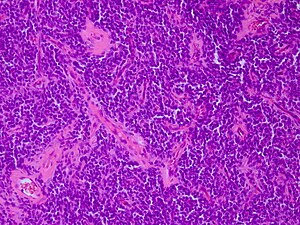Difference between revisions of "Primitive neuroectodermal tumour"
Jump to navigation
Jump to search
(split out) |
Jensflorian (talk | contribs) (infobox) |
||
| Line 1: | Line 1: | ||
{{ Infobox diagnosis | |||
| Name = {{PAGENAME}} | |||
| Image = PNET_Histopathology_HE_200x.jpg | |||
| Width = | |||
| Caption = CNS primitive neuroectodermal tumour [[H&E stain]]. | |||
| Synonyms = CNS-PNET | |||
| Micro = | |||
| Subtypes = | |||
| LMDDx = [[small round blue cell tumours]] | |||
| Stains = | |||
| IHC = S-100 +ve, Syn +/-ve | |||
| EM = | |||
| Molecular = | |||
| IF = | |||
| Gross = | |||
| Grossing = | |||
| Site = brain, spinal cord | |||
| Assdx = | |||
| Syndromes = | |||
| Clinicalhx = | |||
| Signs = | |||
| Symptoms = | |||
| Prevalence = rare - typically in young adults | |||
| Bloodwork = | |||
| Rads = | |||
| Endoscopy = | |||
| Prognosis = poor (WHO Grade IV) | |||
| Other = | |||
| ClinDDx = | |||
| Tx = | |||
}} | |||
It is also known as ''primitive neuroepithelial tumour'' | ''' CNS Primitive neuroectodermal tumour''', abbreviated '''CNS-PNET''', is an uncommon [[neuropathology tumour]] in the group of embryonal tumours. | ||
It is also known as '' supratentorial primitive neuroepithelial tumour'' (supratentorial PNET). | |||
==General== | ==General== | ||
*Should '''not''' be confused with ''peripheral primitive neuroectodermal tumour'' (abbreviated ''[[pPNET]]''<ref name=PST14feb11>PST. 14 February 2011.</ref>), [[AKA]] ''[[Ewing sarcoma]]''. | *Should '''not''' be confused with ''peripheral primitive neuroectodermal tumour'' (abbreviated ''[[pPNET]]''<ref name=PST14feb11>PST. 14 February 2011.</ref>), [[AKA]] ''[[Ewing sarcoma]]''. | ||
*Currently contains a heterogenous group of poorly differentiated WHO grade IV tumours. Major reoganisation of this group will occur in the upcoming WHO classification. | |||
*Mainly children and adolescents. | |||
*Cerebral hemisphere, brain stem or spinal cord. | |||
*There are currently five ICD-O codes assigned within this group: | |||
**9473/3 CNS-PNET, NOS. | |||
**9500/3 CNS neuroblastoma. | |||
**9490/3 CNS ganglioneuroblastoma. | |||
**9501/3 Medulloepithelioma. | |||
**9392/3 Ependymoblastoma. | |||
==Microscopic== | ==Microscopic== | ||
Features: | Features: | ||
*[[Small round blue cell tumour]] - | *[[Small round blue cell tumour]]. | ||
** Focal differentation into astrocytic, neuronal or ependymal phenotypes possible. | |||
==Immunohistocehmistry== | |||
* S-100 +ve. | |||
* INI1 +ve (loss defines tumour as [[ATRT]]). | |||
DDx: | DDx: | ||
* Small round blue cell tumours | |||
* [[Medulloblastoma]] | |||
* [[ATRT]] | |||
*[[Embryonal tumour with abundant neuropil and true rosettes]] (ETANTR).<ref name=pmid19563506>{{cite journal |author=Buccoliero AM, Castiglione F, Degl'Innocenti DR, ''et al.'' |title=Embryonal tumor with abundant neuropil and true rosettes: morphological, immunohistochemical, ultrastructural and molecular study of a case showing features of medulloepithelioma and areas of mesenchymal and epithelial differentiation |journal=Neuropathology |volume=30 |issue=1 |pages=84–91 |year=2010 |month=February |pmid=19563506 |doi=10.1111/j.1440-1789.2009.01040.x |url=}}</ref> | *[[Embryonal tumour with abundant neuropil and true rosettes]] (ETANTR).<ref name=pmid19563506>{{cite journal |author=Buccoliero AM, Castiglione F, Degl'Innocenti DR, ''et al.'' |title=Embryonal tumor with abundant neuropil and true rosettes: morphological, immunohistochemical, ultrastructural and molecular study of a case showing features of medulloepithelioma and areas of mesenchymal and epithelial differentiation |journal=Neuropathology |volume=30 |issue=1 |pages=84–91 |year=2010 |month=February |pmid=19563506 |doi=10.1111/j.1440-1789.2009.01040.x |url=}}</ref> | ||
| Line 25: | Line 74: | ||
[[Category:Neuropathology tumours]] | [[Category:Neuropathology tumours]] | ||
[[Category:Embryonal tumour]] | |||
[[Category:WHO Grade IV tumour]] | |||
Revision as of 06:35, 9 October 2015
| Primitive neuroectodermal tumour | |
|---|---|
| Diagnosis in short | |
 CNS primitive neuroectodermal tumour H&E stain. | |
|
| |
| Synonyms | CNS-PNET |
| LM DDx | small round blue cell tumours |
| IHC | S-100 +ve, Syn +/-ve |
| Site | brain, spinal cord |
|
| |
| Prevalence | rare - typically in young adults |
| Prognosis | poor (WHO Grade IV) |
CNS Primitive neuroectodermal tumour, abbreviated CNS-PNET, is an uncommon neuropathology tumour in the group of embryonal tumours.
It is also known as supratentorial primitive neuroepithelial tumour (supratentorial PNET).
General
- Should not be confused with peripheral primitive neuroectodermal tumour (abbreviated pPNET[1]), AKA Ewing sarcoma.
- Currently contains a heterogenous group of poorly differentiated WHO grade IV tumours. Major reoganisation of this group will occur in the upcoming WHO classification.
- Mainly children and adolescents.
- Cerebral hemisphere, brain stem or spinal cord.
- There are currently five ICD-O codes assigned within this group:
- 9473/3 CNS-PNET, NOS.
- 9500/3 CNS neuroblastoma.
- 9490/3 CNS ganglioneuroblastoma.
- 9501/3 Medulloepithelioma.
- 9392/3 Ependymoblastoma.
Microscopic
Features:
- Small round blue cell tumour.
- Focal differentation into astrocytic, neuronal or ependymal phenotypes possible.
Immunohistocehmistry
- S-100 +ve.
- INI1 +ve (loss defines tumour as ATRT).
DDx:
- Small round blue cell tumours
- Medulloblastoma
- ATRT
- Embryonal tumour with abundant neuropil and true rosettes (ETANTR).[2]
Images
www:
- Primitive neuroectodermal tumour - several images (upmc.edu).
- GBM with PNET component - several images (upmc.edu).
See also
References
- ↑ PST. 14 February 2011.
- ↑ Buccoliero AM, Castiglione F, Degl'Innocenti DR, et al. (February 2010). "Embryonal tumor with abundant neuropil and true rosettes: morphological, immunohistochemical, ultrastructural and molecular study of a case showing features of medulloepithelioma and areas of mesenchymal and epithelial differentiation". Neuropathology 30 (1): 84–91. doi:10.1111/j.1440-1789.2009.01040.x. PMID 19563506.